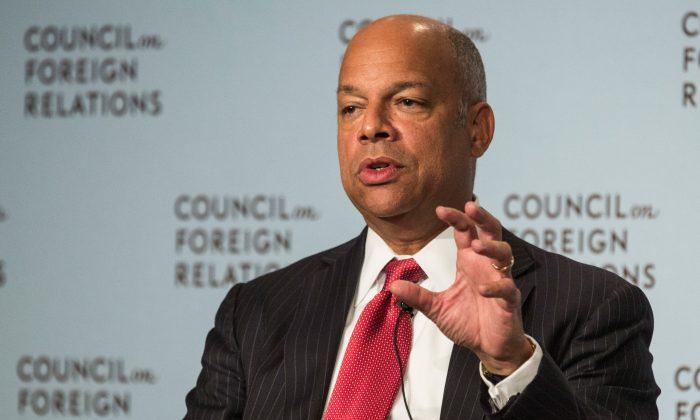WASHINGTON, D.C.—To most Americans, 10 percent unemployment is a crisis. But for Indian Nations 10 percent unemployment would be an historic recovery, according to Jefferson Keel, president of the National Congress of American Indians (NCAI).
“Our people are suffering, but our spirit is not broken,” said Mr. Keel.
Two days after President Obama reported on the state the union, Keel, who is also the lt. governor of the Chickasaw Nation of Oklahoma, delivered his State of Indian Nations address on Jan. 29 at the National Press Club in Washington, D.C. Tribal leaders from around the country were in attendance, as was Assistant Secretary for Indian Affairs Larry Echo Hawk.
Native Voice One and Native American Calling broadcast the address to Native American communities.
Keel spoke about recent successes, challenges, as well as policy requests for the administration. Keel said Indian Nations are strong and growing stronger daily, but, “have much work to do, and now is the time to take action.”
Key issues facing communities are unemployment, education, as well as land use, and financing for growth and development.
Employment is a long-term problem for Indian Nations with an average unemployment of 50 percent on reservations for decades. It “has afflicted our communities for generations,” said Mr. Keel.
He spoke of the reverberating effect of unemployment on the community. High school drop-out rates in Native communities are higher than any other minority in the nation and college graduation rates are the lowest in the United States as well.
“What encouragement does a child have to study and prepare for meaningful work when their parents can’t find a job for years at a time?” Mr. Keel asked.
According to Keel, Native communities’ rates of substance abuse, domestic violence, suicide, and teen births are higher than the rest of the country. Rates of mental health issues are higher in Native American communities and poverty and incarceration rates are well above national averages.
He also spoke of the hope and economic development potential that greater sovereignty has brought and can continue to bring to American Indian communities.
Indian Nations hold more than 50 million acres, about 2 percent of the United States, according to the NCAI. Developing that land has great economic potential, but land consolidation and financing issues have been consistent problems for the communities.
It is specifically on these issues that Keel is requesting President Obama’s assistance. Citing “inaction and delay at the Department of the Interior” in granting federal approval for consolidation of tribal lands for better use, he also blamed “excessive bureaucratic hurdles” for stagnating development on lands ready for use.
Lack of sufficient financing is another key issue and Keel requested that Indian Nations receive the same preferential treatment that state and local governments get on tax exempt bonds, pension plans, benefits, and other financial instruments. Keel called for “clear and fair rules on our legal status and our ability to pursue contracts and loans” so that nations can move forward with economic development projects.
But overall President Keel expressed great hope: the Obama administration’s response thus far to the needs of Indian Nations has been encouraging.
David Gipp, president of the United Tribes Technical College who also attended the address, said that in December President Obama met with “as many tribal leaders as he could” from around the country and that this is the first time a president has met with so many of them.
Gipp thought President Keel’s remarks were on target.
“Tribal nations are very much like third world countries,” said Mr. Gipp. “We have very disparate conditions economically and politically speaking, yet have a lot of resources.”
According to the NCAI, tribal lands contain 10 percent of the nation’s traditional and clean energy resources.
And so, Gipp adds, it is important to invest in tribal communities, “not just because we have endured poverty and other kinds of oppression, but because we have great contributions to make.”
Also present at the address was Assistant Secretary for Indian Affairs Larry Echo Hawk who said he is aware of the many problems facing Indian Country and that unemployment is “definitely one of our priorities to tackle.”
Ron Allen, chairman of the Jamestown S’Klallam Tribe of Western Washington state said of Keel’s address that, “he captured the hope and the encouragement that Indian country feels with respect to this administration.”
This was the NCAI’s 8th annual State of Indian Nation Address. The National Congress of American Indians was founded in 1944 and is the oldest and largest national Indian organization. According to the NCAI, it serves a network of nations whose combined citizenry make up more than three quarters of the American Indian and Alaska Native populations.
“Our people are suffering, but our spirit is not broken,” said Mr. Keel.
Two days after President Obama reported on the state the union, Keel, who is also the lt. governor of the Chickasaw Nation of Oklahoma, delivered his State of Indian Nations address on Jan. 29 at the National Press Club in Washington, D.C. Tribal leaders from around the country were in attendance, as was Assistant Secretary for Indian Affairs Larry Echo Hawk.
Native Voice One and Native American Calling broadcast the address to Native American communities.
Keel spoke about recent successes, challenges, as well as policy requests for the administration. Keel said Indian Nations are strong and growing stronger daily, but, “have much work to do, and now is the time to take action.”
Key issues facing communities are unemployment, education, as well as land use, and financing for growth and development.
Employment is a long-term problem for Indian Nations with an average unemployment of 50 percent on reservations for decades. It “has afflicted our communities for generations,” said Mr. Keel.
He spoke of the reverberating effect of unemployment on the community. High school drop-out rates in Native communities are higher than any other minority in the nation and college graduation rates are the lowest in the United States as well.
“What encouragement does a child have to study and prepare for meaningful work when their parents can’t find a job for years at a time?” Mr. Keel asked.
According to Keel, Native communities’ rates of substance abuse, domestic violence, suicide, and teen births are higher than the rest of the country. Rates of mental health issues are higher in Native American communities and poverty and incarceration rates are well above national averages.
He also spoke of the hope and economic development potential that greater sovereignty has brought and can continue to bring to American Indian communities.
Indian Nations hold more than 50 million acres, about 2 percent of the United States, according to the NCAI. Developing that land has great economic potential, but land consolidation and financing issues have been consistent problems for the communities.
It is specifically on these issues that Keel is requesting President Obama’s assistance. Citing “inaction and delay at the Department of the Interior” in granting federal approval for consolidation of tribal lands for better use, he also blamed “excessive bureaucratic hurdles” for stagnating development on lands ready for use.
Lack of sufficient financing is another key issue and Keel requested that Indian Nations receive the same preferential treatment that state and local governments get on tax exempt bonds, pension plans, benefits, and other financial instruments. Keel called for “clear and fair rules on our legal status and our ability to pursue contracts and loans” so that nations can move forward with economic development projects.
But overall President Keel expressed great hope: the Obama administration’s response thus far to the needs of Indian Nations has been encouraging.
David Gipp, president of the United Tribes Technical College who also attended the address, said that in December President Obama met with “as many tribal leaders as he could” from around the country and that this is the first time a president has met with so many of them.
Gipp thought President Keel’s remarks were on target.
“Tribal nations are very much like third world countries,” said Mr. Gipp. “We have very disparate conditions economically and politically speaking, yet have a lot of resources.”
According to the NCAI, tribal lands contain 10 percent of the nation’s traditional and clean energy resources.
And so, Gipp adds, it is important to invest in tribal communities, “not just because we have endured poverty and other kinds of oppression, but because we have great contributions to make.”
Also present at the address was Assistant Secretary for Indian Affairs Larry Echo Hawk who said he is aware of the many problems facing Indian Country and that unemployment is “definitely one of our priorities to tackle.”
Ron Allen, chairman of the Jamestown S’Klallam Tribe of Western Washington state said of Keel’s address that, “he captured the hope and the encouragement that Indian country feels with respect to this administration.”
This was the NCAI’s 8th annual State of Indian Nation Address. The National Congress of American Indians was founded in 1944 and is the oldest and largest national Indian organization. According to the NCAI, it serves a network of nations whose combined citizenry make up more than three quarters of the American Indian and Alaska Native populations.


